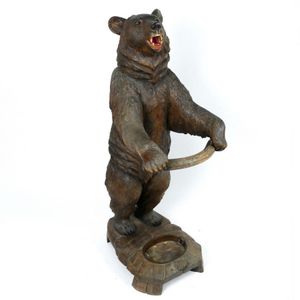Putto with Fish Statue
You must be a subscriber, and be logged in to view price and dealer details.
Subscribe Now to view actual auction price for this item
When you subscribe, you have the option of setting the currency in which to display prices to $Au, $US, $NZ or Stg.
- Lead Statuary and Objects - Lead is a soft, heavy, with a low melting point, making it suitable for detailed moulding. Because of its durability and resistance to corrosion it is suitable for outdoor applications, which has led to its extensive use in garden statues and objects since Roman times.
It develops a silver-grey to lead-grey patina over time.
For garden statuary and objects, it is also a less expensive material to use, than bronze or stone.
However its softness is also a disadvantage as garden statuary made from lead is easily damaged, especially if moulded as a hollow, as for example, in a human or animal form. - Putto / Putti / Amorino / Amorini - A putto (plural: putti) or amerino (plural: amerini) is a cherub or cupid frequently appearing in both mythological and religious paintings and sculpture, especially of the Renaissance and Baroque periods and later used as a decorative element in the design of furniture, ceramics, statuary etc. They are usually depicted as chubby males, or of indeterminate gender, often with wings. Their depiction may represent an association with love, heaven, peace or prosperity.
This item has been included into following indexes:
Visually similar items

A Black Forest carved bear stick stand, modelled standing on its hind feet, its forepaws grasping a stick which forms the support for the walking sticks. Detailed with glass eyes and painted detail to the mouth. Height 108 cm

A Spanish carved polychrome figure of a saint, 47 cm high. Provenance: Property of a Gentleman, Melbourne

An early 19th century bronze figure modelled of an Indian goddess, with curled hair and traditional dress on a rock base. 50 cm high

Gwen Watson, a rare bronze figure of a gypsy, the standing figure holding a basket to one side, a rope held in his left hand, raised on a naturalistic base, incised signature. Height 40 cm, signed G.W.
